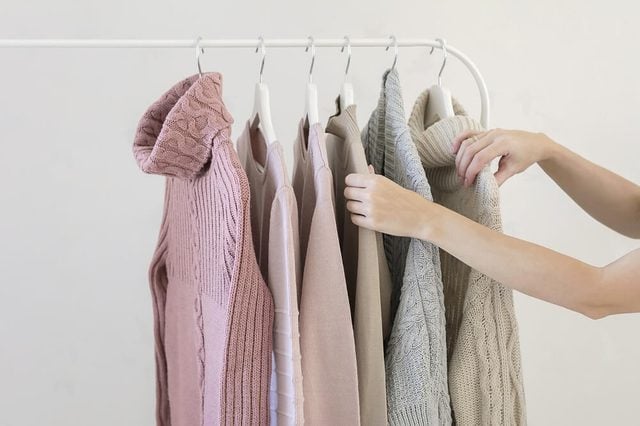This Is the ONLY Way You Should Hang Your Sweaters
Updated: Nov. 10, 2022
Keeping sweaters in the closet seems like a great way to save drawer space—until they start to stretch. Here's how to hang sweaters while keeping the shape.

When your drawers are full, storing your sweaters in your closet can save storage space. There’s just one problem: stretching. Your typical method for hanging shirts tugs the sweater at the shoulders, where it hits the hanger’s curves. Next thing you know, there are unsightly lumps on your favorite winter outfit (speaking of favorites, this $50 quince cashmere sweater sells out every year). Luckily, a simple closet hack will keep your coziest clothes looking good as new. Here are 12 more closet organizing mistakes you make—and how to fix them.
Slipping the hanger through the shirt’s collar just won’t do, so organizing expert Peter Walsh shows a better option on the Rachael Ray Show. Best of all, it doesn’t require any fancy closet organization tools—just a simple hanger.
Start by folding your sweater in half lengthwise on a flat surface, lining the sleeves up with each other. Now lay the hanger on the shirt. The hook should be in the space between the sleeves and the shirt torso, with the bottom of the hanger closest to the neck hole.
Next, fold the sleeves over one of the hanger’s arms and bring the bottom of the sweater over the other side of the hanger. The sleeves and the bottom of the sweater will lie across each other. Pick the hanger up, and the sweater will stay snugly in place, ready to get slipped into your closet—and not a stretch in sight. The weight of the fabric is more evenly distributed, so you can avoid that weird tugging.
If it’s too late and your sweaters already have shoulder bumps, it’s possible to undo the damage. Next time you wash the sweater, gently reshape the shoulders with your fingers, then let it dry flat while resting on a towel. For a quick fix, rub wet fingers vigorously over the misshapen spot. The fibers should mold to your shoulder as they dry, though it might take a couple tries for the fabric to get back to normal.
[Source: rachaelrayshow.com]